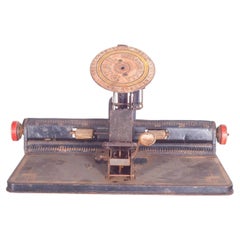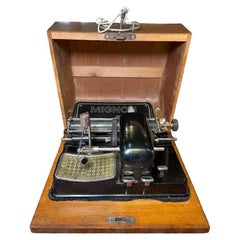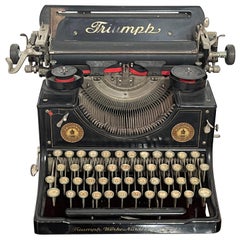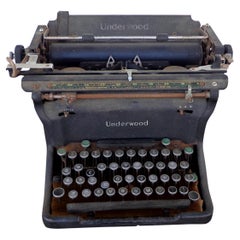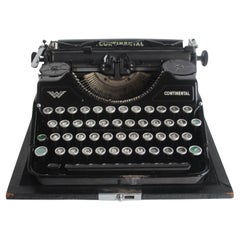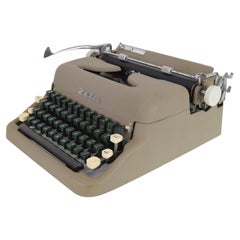Used Typewriters
to
54
334
271
183
94
84
47
8
7
4
3
1
1
2
15
613
148
311
118
4
10
18
58
41
69
95
61
18
35
425
147
147
134
63
340
173
162
155
48
630
630
630
134
70
27
25
23
Sort By
Antique 1945 Smith Corona Sterling Typewriter
By L.C. Smith & Corona Typewriters Inc
Located in Chicago, IL
Antique 1945 Smith Corona Sterling Typewriter
Use this typewriter as decor in your restaurant or
Category
Mid-20th Century American American Classical Historical Memorabilia
Materials
Metal
Antique LC Smith & Corona Super Speed Typewriter c.1942
By L.C. Smith & Corona Typewriters Inc
Located in San Francisco, CA
ABOUT
An original LC Smith & Corona Typewriter with a 14 inch carriage. The serial number is
Category
Early 20th Century Industrial More Desk Accessories
Materials
Metal, Steel
The Toy Typewriter, DIAL Typewriter by Louis Marx and Company
By Louis Marx and Company
Located in Lisboa, Lisboa
The toy typewriter, DIAL Typewriter, is a rare and peculiar model, manufactured in the early 20th
Category
Mid-20th Century American Mid-Century Modern Desk Sets
Materials
Metal
German Mignon Portable Typewriter
By Allgemeine Elektricitats-Gesellschaft
Located in Guaynabo, PR
This is a German Mignon Typewriter. It was made by Allgemeine Elektricitats Gessellschaft. It
Category
20th Century German Industrial Models and Miniatures
Materials
Metal
Triumph Typewriter, Germany, 1930
Located in Palermo, IT
Triumph typewriter, Germany, 1930
Found in a notary's office, signs of aging.
Category
Vintage 1930s German Historical Memorabilia
Materials
Metal
Underwood Vintage Manual Typewriter
By Underwood Universal
Located in Pasadena, TX
Underwood ” Vintage manual typewriter
The Underwood Typewriter Company was a manufacturer of
Category
Vintage 1940s North American Industrial Historical Memorabilia
Materials
Steel
Wanderer “Continental” Typewriter, Germany, 1930s
Located in Praha, CZ
An iconic piece of early 20th-century industrial design, this Continental typewriter by Wanderer
Category
Vintage 1930s German Art Deco Desk Sets
Materials
Metal
Midcentury Typewriter / Consul, 1960s.
Located in Praha, CZ
Made in Czechoslovakia
Made of metal, steel, plastic, fabric
The packaging of the machine has surface defects that are associated with the age of use
Re-polished
The packaging o...
Category
Vintage 1960s Czech Mid-Century Modern Desk Sets
Materials
Metal, Steel
Midcentury Typewriter / Zeta, 1950s.
Located in Praha, CZ
Made in Czechoslovakia
Made of metal, steel, plastic
The packaging of the machine has surface defects that are associated with the age of use,cannot be locked,there is no key.
Re-...
Category
Vintage 1950s Czech Mid-Century Modern Desk Sets
Materials
Metal, Steel
Typewriter Olympia Progress, Germany, 1930s
Located in Praha, CZ
Typewriter by Olympia-Progress, designed by Johannes Kruger in the 1930s, in Germany.
Very good
Category
Vintage 1930s German Industrial More Desk Accessories
Materials
Metal
Vintage 1950s Hermes Rocket Typewriter
Located in Queens, NY
Vintage 1950s Hermes Rocket portable beige plastic typewriter with white square plastic keys and
Category
20th Century Unknown Mid-Century Modern Scientific Instruments
Materials
Plastic
Antique Underwood Typewriter and Table
Located in Mexico City, CDMX
We offer this antique underwood typewriter and table. Both items were found in a place where time
Category
Vintage 1930s American Industrial Desk Sets
Materials
Iron
Manual Portable Typewriter, Corona, Groton, NY.
By Corona
Located in Lisboa, Lisboa
Manual portable typewriter, Corona, Groton, NY. Manufactured by the Corona Typewriter Company of
Category
Early 20th Century American Art Deco Desk Sets
Materials
Metal
Optima Elite 3 Portable Typewriter, Germany
By Elite
Located in Lisboa, Lisboa
The Óptima Elite 3 portable typewriter, grey in colour, was produced at the VEB Optima factory in
Category
Mid-20th Century Italian Modern Desk Sets
Materials
Metal
Manual Typewriter, HCESAR Keyboard from MESSA
Located in Lisboa, Lisboa
Manual typewriter, HCESAR keyboard from MESSA. With a robust design, beige structure and chrome
Category
Mid-20th Century Portuguese Mid-Century Modern Desk Sets
Materials
Metal
Manual Typewriter AZERTY Keyboard by MESSA
Located in Lisboa, Lisboa
Manual typewriter, AZERTY keyboard by MESSA. With a robust design, beige structure and chromed
Category
Mid-20th Century Portuguese Mid-Century Modern Desk Sets
Materials
Metal
Manual Typewriter, AZERTY keyboard by MESSA
Located in Lisboa, Lisboa
Manual typewriter, AZERTY keyboard by MESSA. With a robust design, beige structure and chromed
Category
Mid-20th Century Portuguese Mid-Century Modern Desk Sets
Materials
Metal
American Antique Typewriter Royal, Classic Model
Located in Lisboa, Lisboa
Antique typewriter, Royal. Classic model from the first half of the 20th century, it has a robust
Category
Mid-20th Century American Mid-Century Modern Desk Sets
Materials
Metal
Typewriter/ HERMES 2000, Switzerland 1930s
Located in Praha, CZ
HERMES 2000 is a Swiss product, made in the 1930s by the E. Paillard Company, based in the city of Yverdon
Fully functional
Made of metal, steel, chrome, fabric.
Good original condit...
Category
Vintage 1930s Swiss Art Deco More Desk Accessories
Materials
Metal
Typewriter/ Remington 10S USA, 1920s
Located in Praha, CZ
The packaging of the machine has surface defects that are associated with the age of use.
Made in USA
Serial number Z192196
Fully functional
Made of metal, steel, chrome, fabric.
Go...
Category
Vintage 1920s American Art Nouveau More Desk Accessories
Materials
Metal
Restored Typewriter/ Consul, Czechoslovakia, 1962s
Located in Praha, CZ
The entire machine is expertly disassembled, cleaned, lubricated, all repaired and fully functional.
The packaging of the machine has surface defects that are associated with the ag...
Category
Antique 1660s Czech Mid-Century Modern More Desk Accessories
Materials
Metal
Restored Typewriter, Paillard, Switzerland, 1915
Located in Praha, CZ
The entire machine is expertly disassembled, cleaned, lubricated, all repaired and fully functional
The packaging of the machine has surface defects that are associated with the age...
Category
Vintage 1910s Swiss Art Nouveau More Desk Accessories
Materials
Metal
Restored Typewriter/ Triumph, Germany, 1915
Located in Praha, CZ
The entire machine is expertly disassembled, cleaned, lubricated, all repaired, and fully functional
The packaging of the machine has surface defects that are associated with the ag...
Category
Vintage 1910s German Art Deco More Desk Accessories
Materials
Metal
Typewriter Olivetti "M44", East Germany, 1947
Located in Praha, CZ
Oldschool typewriter "M44" made by Olivetti, in East Germany, in the year 1947.
Made of metal and
Category
Vintage 1940s German Industrial More Desk Accessories
Materials
Metal, Chrome
Typewriter by Bar-Lock, England, 1921
Located in Praha, CZ
Oldschool typewriter made by Bar-Lock, in England, in the year 1921.
Made of bakelite, metal and
Category
Vintage 1920s German Industrial More Desk Accessories
Materials
Bakelite
Vintage Smith Corona Typewriter and Case
Located in Pasadena, TX
Vintage Smith corona typewriter and case.
Black Smith Corona standard typewriter made in USA
Category
Vintage 1940s North American Industrial More Desk Accessories
Materials
Metal
Italian Typewriter Olivetti 1930 Ivrea M40
By Olivetti
Located in Palermo, Sicily
Italian typewriter Olivetti 1930 Ivrea M40.
Category
Vintage 1940s Italian Mid-Century Modern Desk Sets
Materials
Metal
Olivetti "Valentine" Typewriter by Ettore Sottsass
By Olivetti, Ettore Sottsass
Located in Vienna, AT
Famous portable typewriter by Sottsass for Olivetti, Italy from the 1960s.
Totally functional with
Category
Vintage 1960s Italian Mid-Century Modern More Desk Accessories
Materials
Steel
Antique Remington Model 5 Typewriter c.1938
By E. Remington and Sons
Located in San Francisco, CA
ABOUT
A refurbished Art Deco Remington Model 5 typewriter with black, crinkle finish and original
Category
Early 20th Century Industrial More Desk Accessories
Materials
Steel, Nickel
Vintage 1930s Remington Typewriter in Original Case
By E. Remington and Sons
Located in Torquay, GB
Exceptional vintage typewriter by Remington Inc. USA. circa 1930s.
Offered in original leather
Category
Early 20th Century American Art Deco Desk Sets
Materials
Steel
Vintage Consul Typewriter with Case, Czechoslovakia, 1960s
Located in Praha, CZ
Example of mid-century industrial design, this “Consul” typewriter was manufactured in
Category
Vintage 1970s Czech Mid-Century Modern Desk Sets
Materials
Metal
Typewriter/Remington Standart 12 USA, 1930s
Located in Praha, CZ
The packaging of the machine has surface defects that are associated with the age of use.
Made in USA.
Fully functional.
Made of metal, steel, chrome, fabric.
Good original condition...
Category
Vintage 1920s American Art Nouveau More Desk Accessories
Materials
Metal
Typewriter/ Olivetti Studio 42, Italy 1946
Located in Praha, CZ
Fully functional
Made of metal, steel, chrome, fabric.
Good original condition
The machine has a crooked bottom edge
Category
Vintage 1940s Italian Mid-Century Modern More Desk Accessories
Materials
Metal
Vintage Underwood Champion Portable Typewriter c.1946
Located in San Francisco, CA
ABOUT
A vintage portable Underwood Champion Four bank typewriter in grey finish and original case
Category
Early 20th Century Industrial Scientific Instruments
Materials
Steel
Midcentury Typewriter/Consul, Type 2224, 1980s
Located in Praha, CZ
Made in Czechoslovakia
Made of Metal, Steel, Plastic,
Re-polished
With aged patina
Original condition.
Category
Vintage 1980s Czech Mid-Century Modern Desk Sets
Materials
Metal, Steel
Midcentury Typewriter/Consul, Type 222.2, 1970s
Located in Praha, CZ
Made in Czechoslovakia
Made of Metal, Steel, Plastic, Fabric
The packaging of the machine has surface defects that are associated with the age of use
Re-polished
The packaging o...
Category
Vintage 1970s Czech Mid-Century Modern Desk Sets
Materials
Metal, Steel
Restored Typewriter/ Remington Portable, USA, 1910s
Located in Praha, CZ
The entire machine is expertly disassembled, cleaned, lubricated, all repaired and fully functional.
The packaging of the machine has surface defects that are associated with the ag...
Category
Vintage 1910s American Art Deco More Desk Accessories
Materials
Metal
Mid-Century Typewriter Olympia-Plana, Germany, 1940
Located in Praha, CZ
Typewriter by Olympia-Plana, manufactured in the 1940's, in Germany
Made of metal and plastic
Category
Vintage 1940s German Art Nouveau More Desk Accessories
Materials
Metal
Oldschool Typewriter by Mirsa Ideal, Germany, 1934
Located in Praha, CZ
Typewriter manufactured by Mirsa Ideal, made in Germany, in the 1930's.
Made of metal.
Repolished
Category
Vintage 1930s German Art Deco More Desk Accessories
Materials
Metal
Vintage Olivetti Portable Typewriter Model Lettera 27
By Olivetti
Located in Palermo, IT
Olivetti portable typewriter model Lettera 27.
Intact and functional, equipped with transport cover
Category
Vintage 1980s Italian Desk Sets
Materials
Metal
$362 Sale Price
20% Off
H 3.55 in W 11.82 in D 12.21 in
Portable Typewriter Continental 340, Germany 1937
Located in Praha, CZ
Made in Germany. Production in the years 1931-1940
Made of metal, steel, chrome,
Polished
Good original condition, functional.
Category
Vintage 1930s German Art Deco Desk Sets
Materials
Metal
Mid-century Typewriter/Consul, 1960's
Located in Praha, CZ
Made in Czechoslovakia
Made of Metal,Plastic
With aged patina
Re-polished
Fully Functional
Good Original condition.
Category
Vintage 1960s Czech Mid-Century Modern More Desk Accessories
Materials
Metal
Mid-Century Typewriter/Zeta, 1960's
Located in Praha, CZ
Made in Czechoslovakia
Made of metal
Re-polished
Original condition.
Category
Vintage 1960s Czech Mid-Century Modern More Desk Accessories
Materials
Metal
Remington Standard Model 10 Typewriter Circa 1910
Located in Opole, PL
Remington Standard Model 10 Typewriter Circa 1910
The model, likely from 1910 with serial number
Category
Early 20th Century European Desk Sets
Materials
Metal
French Antique Contin Typewriter from the, 1940s
Located in Godshill, Isle of Wight
French antique Contin Typewriter from the 1940s
This is a Contin Continsouza Paris, Modèle A n
Category
Early 20th Century Industrial Scientific Instruments
Materials
Metal
Mid Century Industrial Typewriter Table with Drop Leafs
Located in Freehold, NJ
This vintage industrial typewriter table features metal construction, gray painted finish, two drop
Category
Mid-20th Century American Industrial Carts and Bar Carts
Materials
Metal
1977 Milton Glaser - Olivetti Typewriter Original Vintage Poster
By Milton Glaser
Located in Winchester, GB
created in promotion of Italian typewriter brand Olivetti. Featuring typical Glaser illustration, the
Category
Vintage 1970s Italian Posters
Materials
Paper
$380 Sale Price
20% Off
H 26.8 in W 18.9 in D 0.1 in
Mid-century Typewriter Consul, 1960's Czechoslovakia
Located in Praha, CZ
Made in Czechoslovakia in the 1960's by Consul.
Made of metal, plastic, chrome.
With aged patina
Fully functional, re-polished, in original condition with signs of wear.
Category
Vintage 1960s Czech Mid-Century Modern More Desk Accessories
Materials
Metal, Chrome
Vintage Royal Quiet De Luxe Typewriter with case
Located in Pasadena, TX
This is an vintage typewriter. It's a Royal De Luxe. All of the keys work. Needs a new ribbon
Category
20th Century American Historical Memorabilia
Materials
Metal
Typewriter "tbm de Luxe", by UNIS, Bosnia, 1985
Located in Praha, CZ
Typewriter "tbm de Luxe" manufactured by UNIS, in the year 1985, in today's Bosnia.
Made of metal
Category
Vintage 1980s Swiss Art Nouveau More Desk Accessories
Materials
Metal
1950's Triumph Brand Gabriele Model Portable Typewriter
Located in Mexico City, CDMX
Circa 1950. We offer this toatlly NEW Triumph Brand Gabriele Model Portable Typewriter. This item
Category
Vintage 1930s American Mid-Century Modern Desk Sets
Materials
Steel
Italian Typewriter by Marcello Nizzoli for Olivetti, 1950s
By Olivetti, Marcello Nizzoli
Located in Byron Bay, NSW
Lettera 22 portable typewriter, of enameled metal and plastic, designed by Marcello Nizzoli and
Category
Vintage 1950s Italian Mid-Century Modern Desk Sets
Materials
Metal
French Green Majolica Money Bank Typewriter Circa 1950
Located in Austin, TX
French Green Majolica Money Bank Typewriter Circa 1950.
Category
Vintage 1950s French Mid-Century Modern Decorative Boxes
Materials
Ceramic
Ettore Sottsass for Olivetti Valentine Typewriter, Italy 1960s
By Olivetti, Ettore Sottsass
Located in Naples, IT
Famous and Iconic Portable Typewriter Mod. Valentine designed by Ettore Sottsass and Peter King
Category
Vintage 1960s Mexican Mid-Century Modern Desk Sets
Materials
Metal
Restored Typewriter/ Consul, Model 2226, Czechoslovakia, 1965s
Located in Praha, CZ
The entire machine is expertly disassembled, cleaned, lubricated, all repaired and fully functional
The packaging of the machine has surface defects that are associated with the age...
Category
Antique 1660s Czech Mid-Century Modern More Desk Accessories
Materials
Metal
George Nelson Walnut Executive and Typewriter Desk Set
By Herman Miller, George Nelson
Located in Brooklyn, NY
Mid-Century Modern, Executive Office Group desk model 9959 and typewriter return desk model 4751 by
Category
Mid-20th Century American Mid-Century Modern Desks and Writing Tables
Materials
Steel
Italian Typewriter "Olivetti Linea 88", Design Ettore Sottsass, 1966
By Olivetti, Ettore Sottsass
Located in Palermo, IT
Italian typewriter "Olivetti Linea 88", Design Ettore Sottsass, 1966
Good condition.
Features
Category
Vintage 1960s Italian Historical Memorabilia
Materials
Metal
$727
H 7.88 in W 17.33 in D 16.54 in
Manual Typewriter AZERTY keyboard, by OLYMPIA, Regina de Luxe
Located in Lisboa, Lisboa
Manual typewriter, AZERTY keyboard, by OLYMPIA, Regina de Luxe. With a beige structure, chrome
Category
Mid-20th Century German Mid-Century Modern Desk Sets
Materials
Metal
- 1
Get Updated with New Arrivals
Save "Used Typewriters", and we’ll notify you when there are new listings in this category.
Used Typewriters For Sale on 1stDibs
An assortment of used typewriters is available at 1stDibs. Frequently made of metal, plastic and steel, all used typewriters available were constructed with great care. Used typewriters have been made for many years, and versions that date back to the 19th Century alongside those produced as recently as the 20th Century. Used typewriters are generally popular furniture pieces, but Mid-Century Modern, Industrial and Art Deco styles are often sought at 1stDibs. Many used typewriters are appealing in their simplicity, but Ettore Sottsass, Olivetti and Perry King produced popular used typewriters that are worth a look.
How Much are Used Typewriters?
Prices for used typewriters can differ depending upon size, time period and other attributes — at 1stDibs, used typewriters begin at $128 and can go as high as $7,500, while the average can fetch as much as $651.
More Ways To Browse
Franco Albini Lb7
Lb7 Bookcase
Austrian Music Box
Henredon Drawer With Light
Typewriter Stand
File Cabinet End Table
Mechanical Calculator
Inlay Music Box Table
Lc 14
Bedding Brevetti
Ettore Sottsass Flying
Fax Machine
G Plan Room Divider
Gae Aulenti King Sun
King Sun Gae
Triumph Motorcycle
Ettore Sottsass Harlow
Flying Carpet Sottsass


